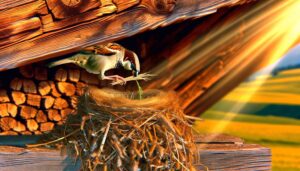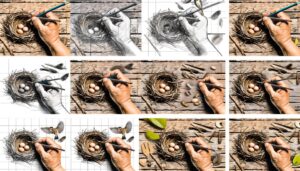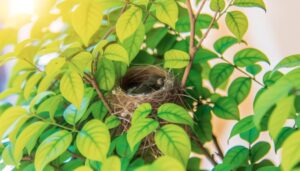5 Simple Steps to Deter Sparrows from Nesting
To deter sparrows from nesting, install bird spikes made of stainless steel or polycarbonate on ledges. Hang reflective objects like CDs or aluminum foil strips near problem areas.
Secure bird netting with proper anchoring points at potential nesting sites. Apply gel repellents evenly on cleaned surfaces using a caulking gun.
Use ultrasonic or bioacoustic sound deterrents near nesting zones and change patterns regularly. Inspect and seal entry points with weather-resistant sealants and metal meshes.
Remove loose nesting materials and trim overgrown vegetation. Place bird decoys with movement near nesting areas.
Keep your property clean and organized. Discover additional detailed techniques next.
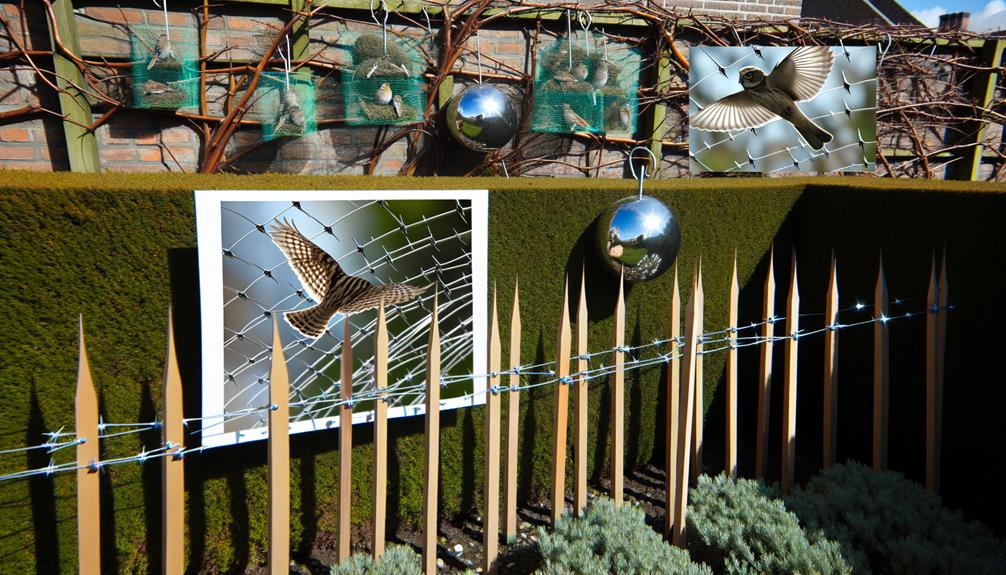
Key Takeaways
- Install bird spikes on ledges to prevent sparrows from landing and nesting.
- Use reflective objects like CDs or foil strips to deter sparrows from nesting areas.
- Secure bird netting around potential nesting sites to block access.
- Apply gel repellents evenly on surfaces to make them unappealing for nesting.
- Position ultrasonic or bioacoustic devices near nesting sites to create an unwelcoming environment.
Install Bird Spikes
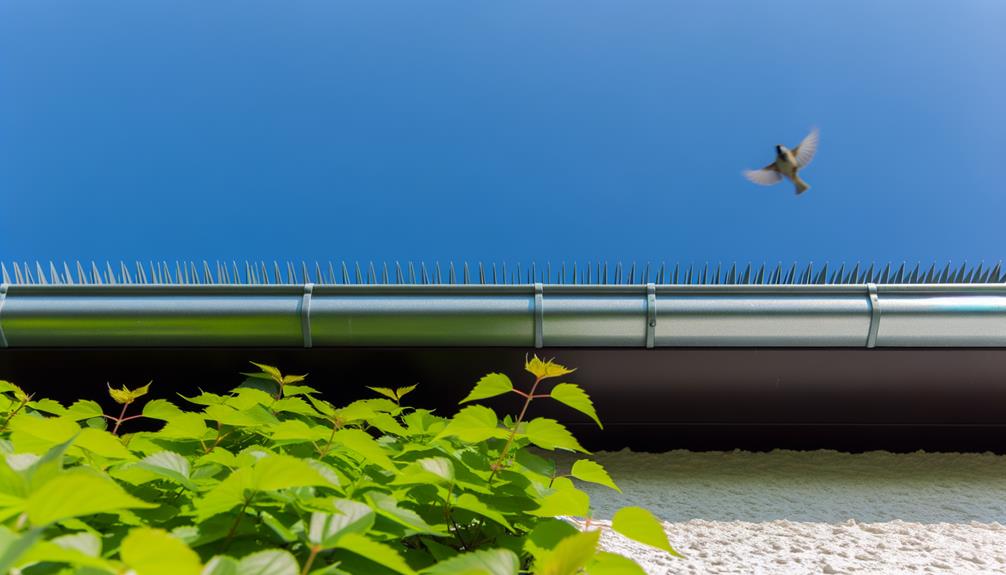
To effectively deter sparrows from nesting on ledges and other surfaces, install bird spikes to create an inhospitable environment. Start by selecting stainless steel or polycarbonate spikes, known for durability and resistance to weather conditions.
Measure the ledge dimensions, making certain you've enough spikes to cover the entire area. Clean the surface thoroughly to remove any debris, which guarantees proper adhesion. Use a strong adhesive or screws to secure the spikes in place, following the manufacturer's instructions closely.
Check that the spikes are evenly spaced to prevent birds from landing. Regularly inspect the spikes for any damage or displacement. By installing bird spikes, you'll create a space that discourages sparrows, supporting your goal to serve and protect your community.
Use Reflective Objects
Hang reflective objects like CDs or aluminum foil strips around your property to create visual deterrents that confuse and scare sparrows. These objects reflect sunlight, producing unpredictable flashes of light that disrupt the birds' sense of safety.
Place them strategically in problem areas such as eaves, gutters, and ledges where sparrows are likely to nest. Make sure the reflective items are securely fastened to prevent them from being dislodged by wind. Additionally, vary the length and placement of these objects to maximize their deterrent effect.
Regularly inspect and adjust the positions to maintain their efficacy. By employing this method, you're creating an environment that discourages sparrows from settling, contributing to a more bird-free property.
Place Bird Netting
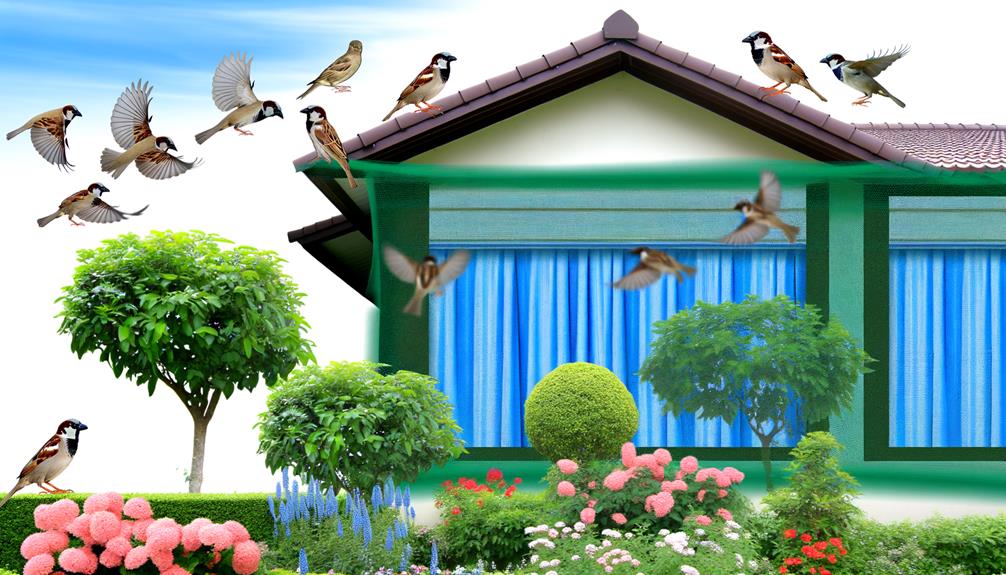
To effectively deter sparrows, start by selecting netting with the correct mesh size to prevent them from passing through.
Next, install the netting securely around potential nesting sites, guaranteeing there are no gaps or loose areas.
Regularly inspect and maintain the netting to make sure it remains intact and functional.
Choose Appropriate Netting
Selecting the appropriate bird netting involves considering the material's durability, mesh size, and the specific areas you need to protect.
Resilient materials such as polyethylene or polypropylene offer long-lasting protection against weather and UV rays.
For effective sparrow deterrence, choose a mesh size of 1/2 inch or smaller; this prevents the small birds from slipping through.
Evaluate the areas you need to shield—whether it's eaves, balconies, or garden spaces—to determine the netting dimensions required. Measuring accurately guarantees you cover all entry points without gaps.
Secure Netting Properly
Ensuring the netting is secured properly starts with anchoring it firmly to the designated area. This stability is vital for preventing sparrows from finding gaps or weak points.
Follow these steps methodically:
- Measure and Cut: Measure the area precisely and cut the netting to fit, ensuring it covers all necessary spaces without sagging.
- Anchor Points: Use strong, weather-resistant hooks or ties at multiple points, ideally at intervals of 6-12 inches, to secure the netting.
- Edge Sealing: Seal all edges tightly, using additional ties or clamps if necessary, to prevent sparrows from slipping through.
Monitor and Maintain Netting
Regular monitoring and maintenance of the netting guarantee its effectiveness in deterring sparrows from nesting. Inspect the netting weekly for any signs of wear, tears, or gaps. Confirm that all edges remain tightly secured and that no sections have sagged. If you find any damage, promptly repair it using zip ties or replacement netting.
Clean the netting periodically to remove debris that might weaken its structure or attract other pests. Document your inspections and maintenance activities in a log for future reference. By staying vigilant and methodical in your approach, you'll provide a consistent barrier, assuring sparrows find no opportunity to nest.
This attention to detail helps maintain a bird-friendly environment while protecting structures from potential damage.
Apply Gel Repellents
Applying gel repellents effectively deters sparrows by creating an uncomfortable, sticky surface they instinctively avoid.
To apply gel repellents correctly, follow these steps:
- Identify Target Areas: Locate common nesting sites such as ledges, beams, and gutters. Sparrows prefer these sheltered spots for building their nests.
- Clean the Surface: Make sure the areas are free from debris and droppings. A clean surface enhances the repellent's adhesion and effectiveness.
- Apply the Gel: Use a caulking gun to apply a continuous bead of gel along the identified areas. Maintain uniformity to prevent gaps where sparrows might land.
Use Sound Deterrents
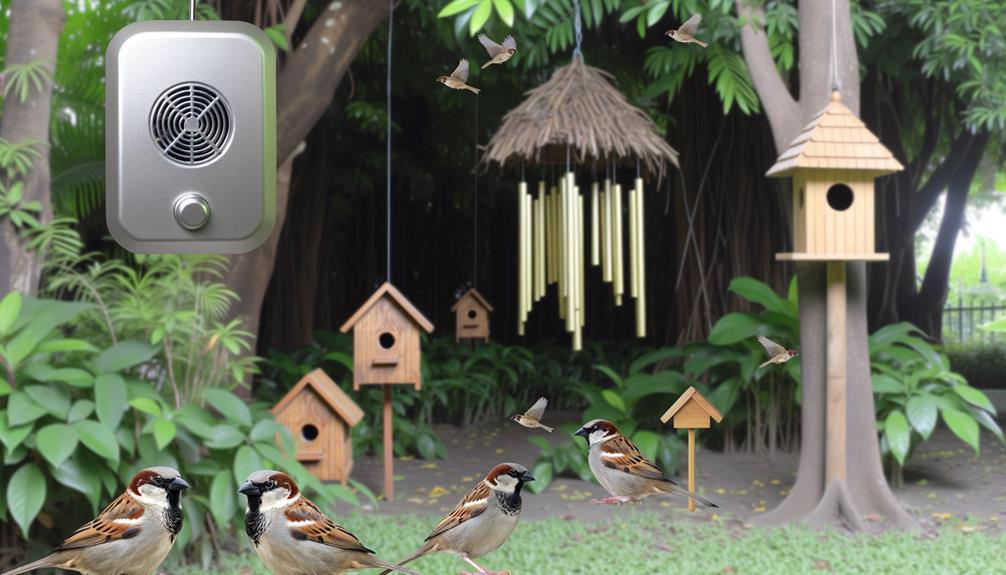
Utilizing sound deterrents effectively disrupts sparrows' nesting behavior by emitting noises that mimic predators or create an uncomfortable environment.
You can employ ultrasonic devices that emit high-frequency sounds, imperceptible to humans but disturbing to sparrows. These devices work continuously, ensuring a persistent deterrent.
Alternatively, consider bioacoustic devices that play recorded predator calls. Set them to activate at intervals, simulating a natural threat.
For best results, place these devices near common nesting sites like eaves and ledges. Regularly change the sound patterns to prevent sparrows from becoming habituated.
By strategically positioning and maintaining these sound deterrents, you'll create an unwelcoming environment, encouraging sparrows to seek nesting locations elsewhere.
This method aligns well with humane, non-invasive deterrence practices.
Install Motion-Activated Sprinklers
To deter sparrows effectively, you can install motion-activated sprinklers that cover strategic areas. These devices not only save water by targeting specific zones but also create a sudden, unpredictable environment that discourages nesting.
Guarantee proper placement by following manufacturer guidelines for best coverage.
Effective Coverage Areas
Motion-activated sprinklers, strategically placed, can effectively deter sparrows from nesting by covering key areas with sudden bursts of water. To maximize efficacy, identify and target primary nesting zones.
- Entry Points: Install sprinklers near doorways, windows, and any small openings to prevent sparrows from entering structures.
- Common Nesting Sites: Position sprinklers under eaves, awnings, and gutters where sparrows typically build nests.
- Feeding Areas: Place sprinklers in gardens or near bird feeders to discourage sparrows from frequenting these spots.
Water Conservation Benefits
By installing motion-activated sprinklers, you can reduce water waste while effectively deterring sparrows from nesting. These sprinklers only activate when motion is detected, ensuring water is used only when necessary. This method conserves resources and offers a humane way to keep sparrows away.
Consider the following benefits:
| Feature | Benefit |
|---|---|
| Motion Detection | Reduces unnecessary water use |
| Timed Activation | Limits water usage duration |
| Targeted Coverage | Sprays specific areas |
| Adjustable Sensitivity | Customizes detection range |
| Eco-Friendly Solution | Minimizes environmental impact |
Using motion-activated sprinklers aligns with sustainable practices, making it a responsible choice for those committed to water conservation and wildlife-friendly deterrence. This method combines efficiency with ecological responsibility, ensuring your efforts serve both your property and the environment.
Installation Tips
When installing motion-triggered sprinklers, position the units at strategic locations where sparrows frequently attempt to nest. Assess your area to identify high-traffic zones for these birds.
Motion-triggered sprinklers work by detecting movement and releasing a burst of water, effectively startling sparrows and discouraging them from nesting.
To achieve peak performance, follow these steps:
- Height Adjustment: Set the sprinkler at a level that covers the target area without causing water wastage.
- Sensitivity Settings: Adjust the sensor sensitivity to detect small movements without triggering unnecessarily.
- Coverage Area: Ensure overlapping coverage zones to avoid blind spots where sparrows could nest undisturbed.
Proper installation requires precision and attention to detail, guaranteeing you create a sparrow-free environment efficiently.
Seal Entry Points

To effectively prevent sparrows from entering your home, start by meticulously inspecting and sealing all potential entry points, such as gaps around windows, doors, and eaves. Use a weather-resistant sealant to close any small cracks or openings.
For larger gaps, consider installing metal mesh or hardware cloth to block access. Pay special attention to vents and chimneys; installing bird-proof covers can deter sparrows without disrupting airflow.
Regularly inspect these areas, as weather and time can create new entry points. By systematically addressing and sealing these vulnerabilities, you'll create a robust barrier, ensuring sparrows won't find your home inviting.
Your methodical approach not only safeguards your living space but also enhances the well-being of those you serve.
Remove Nesting Materials
To effectively deter sparrows, you need to eliminate loose debris around your property, as these materials attract them for nesting.
Guarantee you secure trash bins with tight-fitting lids to prevent access to potential nesting components.
Eliminate Loose Debris
Removing loose debris around your property makes it less attractive for sparrows seeking nesting materials. Sparrows often utilize small twigs, leaves, and grass clippings to construct their nests.
To deter them effectively, you need to systematically eliminate these potential materials. Start by conducting a thorough inspection of your yard. Focus on areas that might accumulate debris naturally or through human activity.
Use the following steps to methodically remove loose debris:
- Rake Leaves Regularly: Gather and dispose of fallen leaves, especially during autumn.
- Trim Overgrown Vegetation: Cut back any shrubs or plants that may drop twigs or leaves.
- Clear Gutters and Drains: Regularly clean out gutters to prevent leaf buildup.
This detailed approach guarantees your property remains unappealing to nesting sparrows.
Secure Trash Bins
Why is it important to secure your trash bins when aiming to deter sparrows from nesting? Sparrows are opportunistic and often use discarded materials to build their nests.
By ensuring your trash bins are tightly sealed, you eliminate access to potential nesting materials like paper, twigs, and food scraps.
First, check that your bins have lids that close securely.
Second, consider placing heavy objects on top of the lids to prevent sparrows from prying them open.
Finally, regularly clean around the bins to remove any debris that might attract sparrows.
Use Bird Decoys
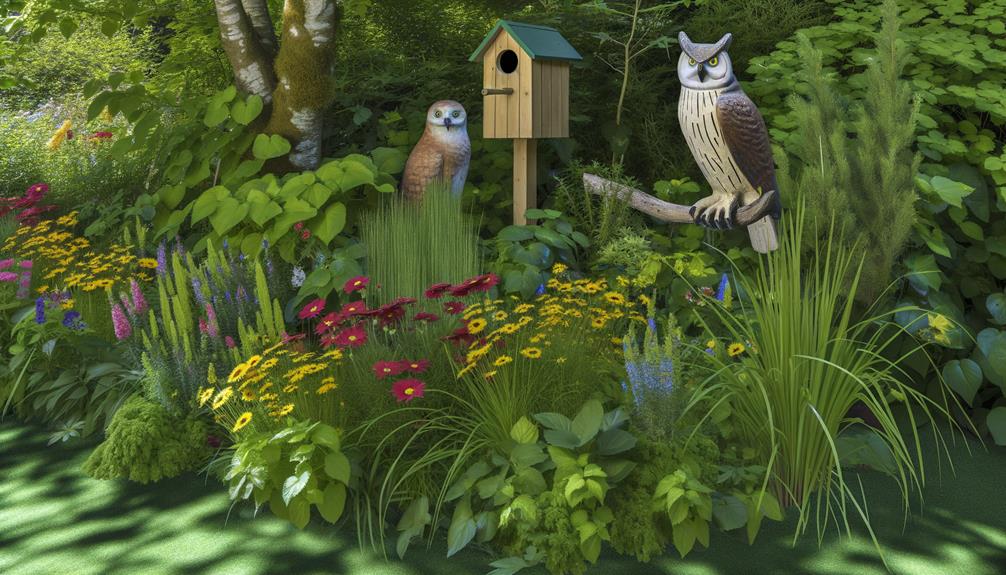
Placing bird decoys, such as owls or hawks, near potential nesting sites can effectively deter sparrows by exploiting their natural fear of predators.
To maximize effectiveness, follow these steps:
- Positioning: Place decoys at visible locations near eaves, porches, or any suspected nesting areas. Sparrows need a clear line of sight to be deterred.
- Movement: Opt for decoys with moving parts or reflective surfaces. Motion increases the realism, enhancing the deterrent effect.
- Maintenance: Regularly change the decoys' positions. Sparrows can become accustomed to stationary objects, so frequent repositioning maintains their fear.
Utilizing these methods will help you create a less inviting environment for sparrows, supporting your goal of maintaining a sparrow-free property.
Maintain Clean Property
In addition to using decoys, maintaining a clean property can greatly reduce the likelihood of sparrows choosing your space to nest. Start by removing food sources, such as bird feeders or fallen seeds, which attract sparrows. Regularly trim bushes and trees to eliminate potential nesting sites. Dispose of debris and clutter where sparrows might hide or gather materials.
| Action | Frequency | Purpose |
|---|---|---|
| Remove food sources | Weekly | Reduce attraction |
| Trim vegetation | Monthly | Eliminate nesting sites |
| Clear debris | Bi-weekly | Remove hiding places |
Conclusion
By blending reflective objects with gel repellents and employing bird spikes alongside sound deterrents, you create a multi-faceted defense against sparrows.
Sealing entry points and removing nesting materials makes sure they're unwelcome.
While bird decoys deceive, a clean property maintains the facade.
This juxtaposition of methods—both preventive and reactive—offers a thorough, scientific approach to deter sparrows.
Your calculated strategy not only protects your space but also promotes a harmonious balance between human habitations and nature.

